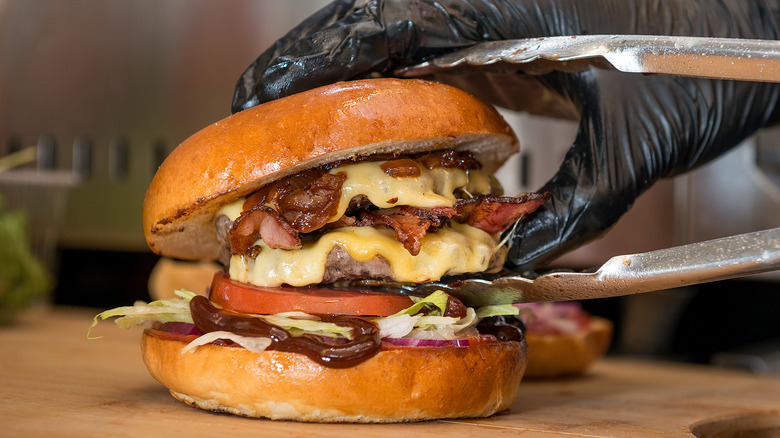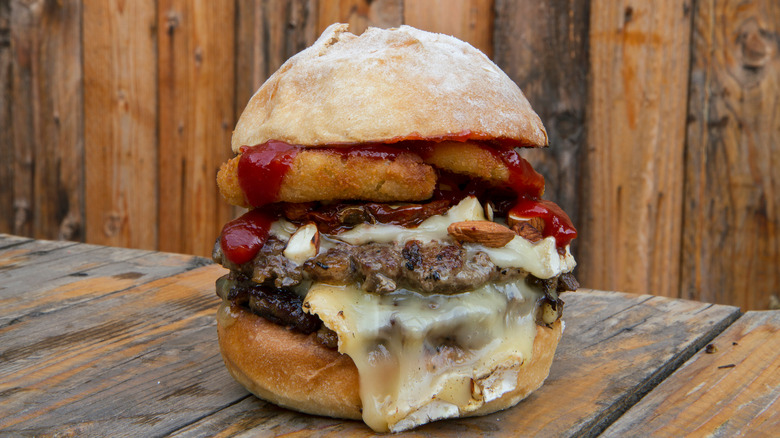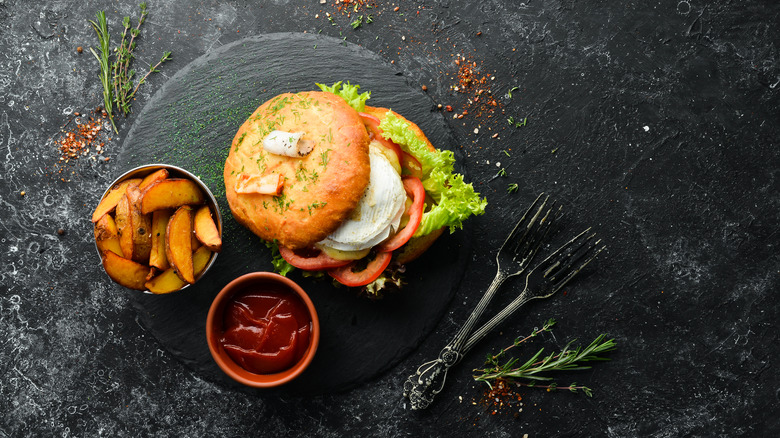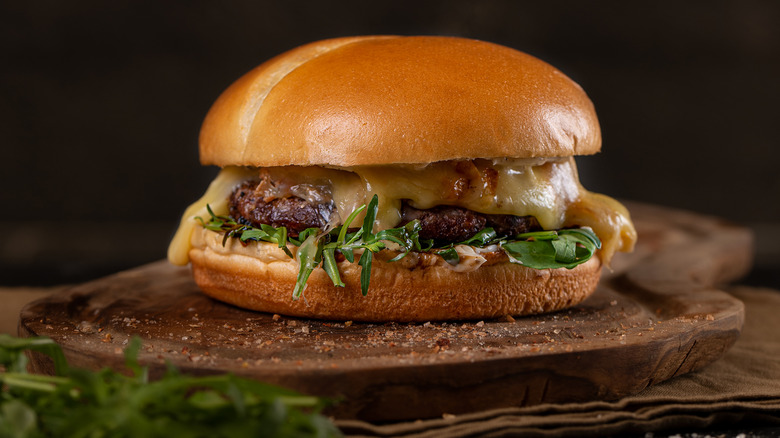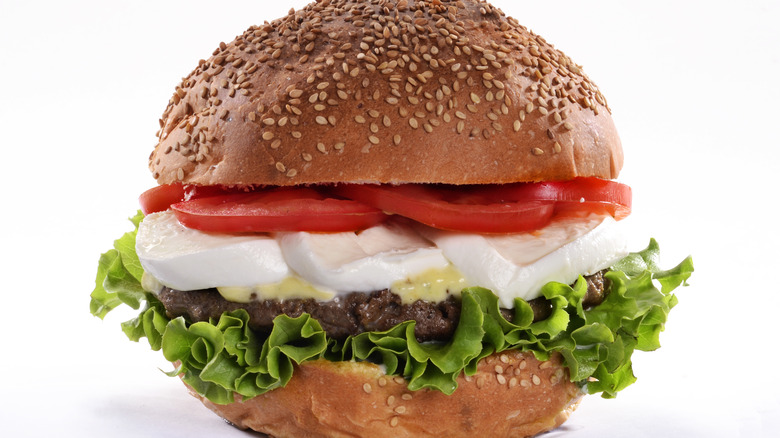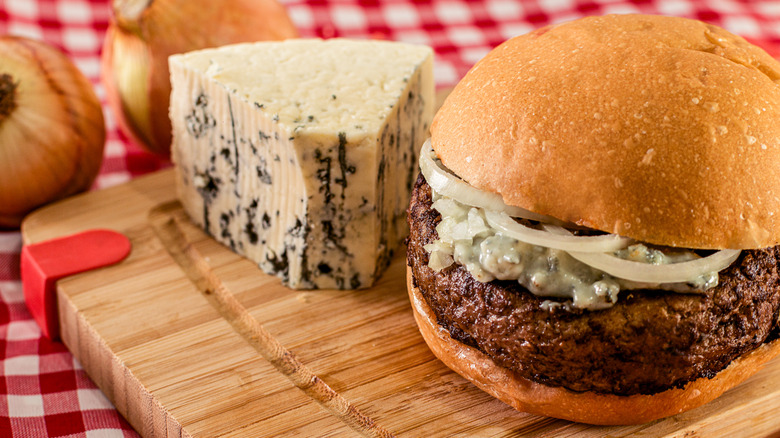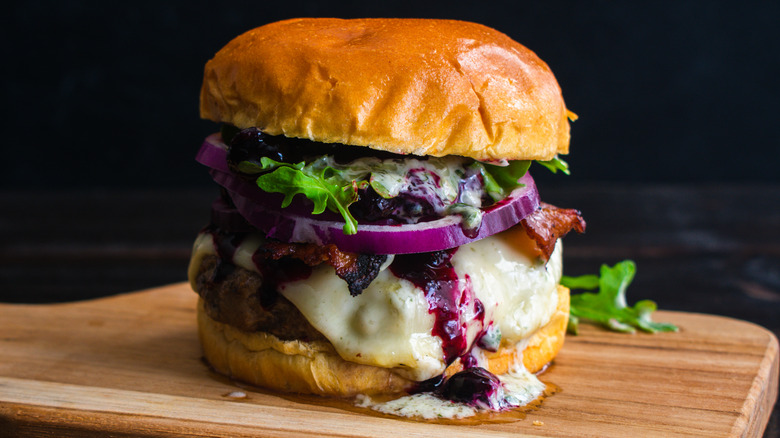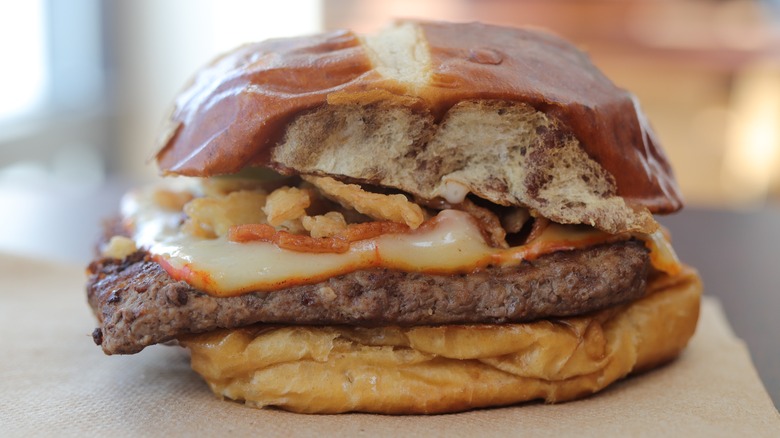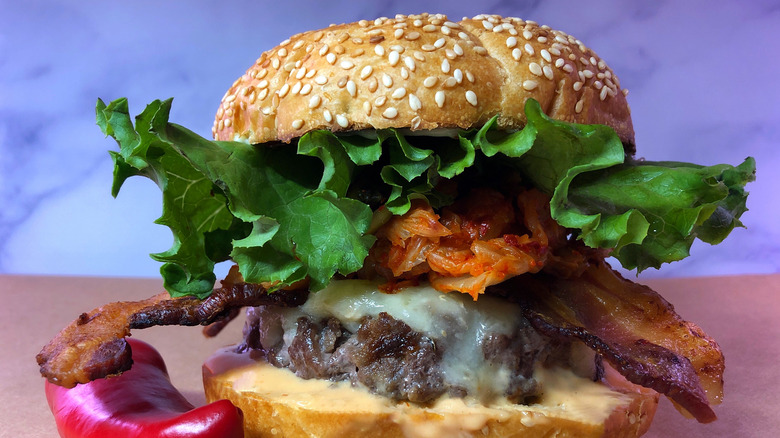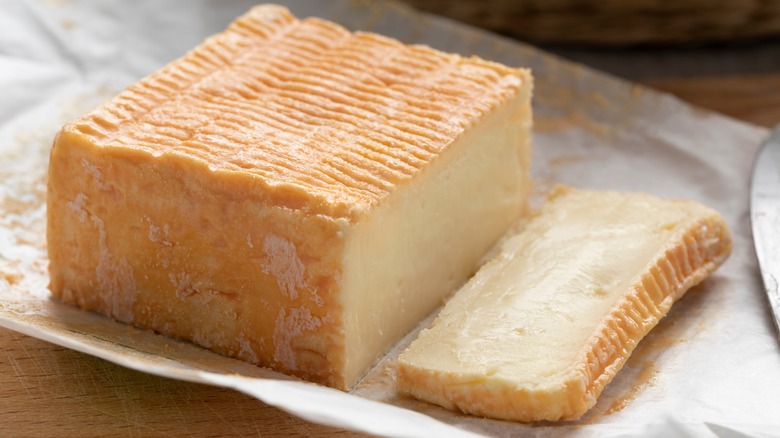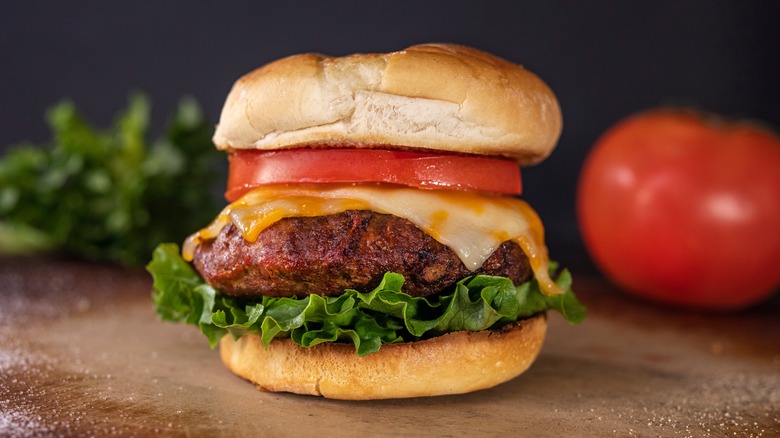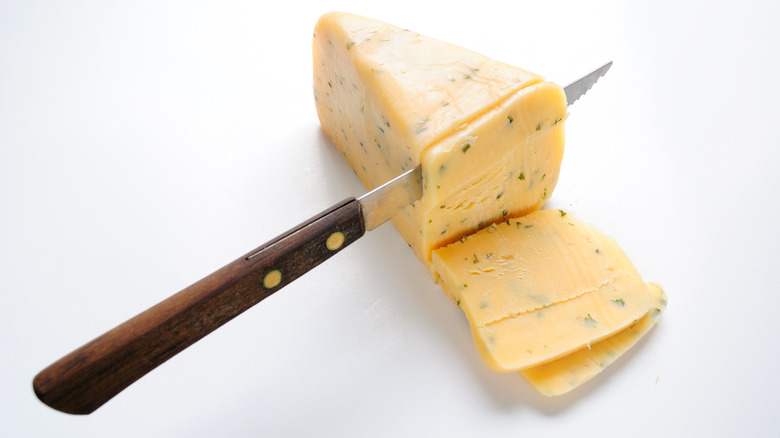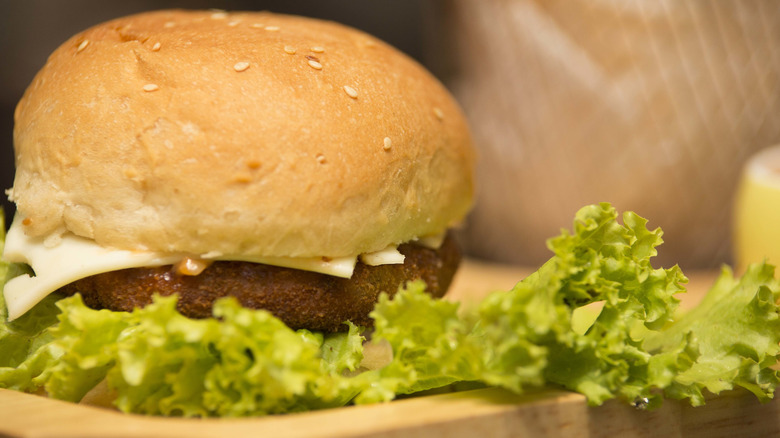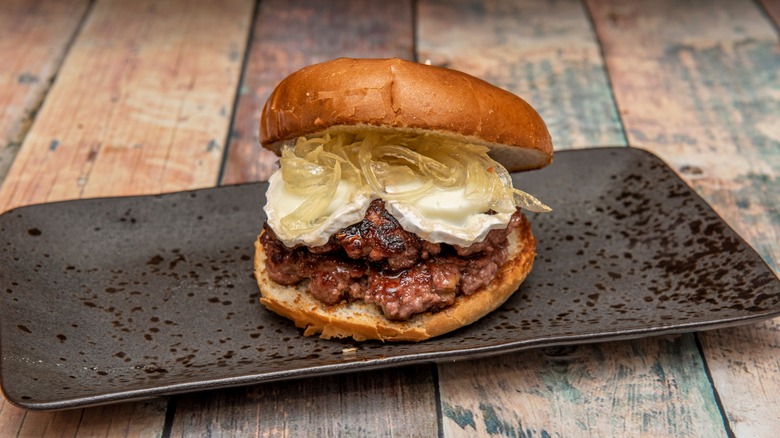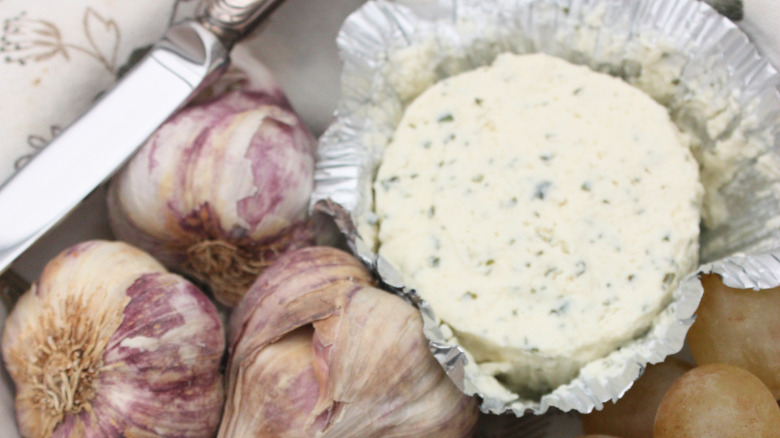14 Underrated Cheeses To Add To Your Next Burger
We've all got a favorite burger cheese. It's hard not to be a cheddar fan, with its classic sharp flavor and meltability. Monterey Jack's mild, creamy character makes it a great choice for your patty, adding a soft, gooey layer without taking over flavor. Plenty of burger aficionados swear by American, the cheese that's not actually a cheese, thanks to its impeccable meltiness and smooth texture. A cheeseburger fan could happily go through life using only these three choices.
But if you possess a sense of adventure, a desire to think outside the burger box, there's a world of cheeses out there just waiting to be introduced to a beef patty (or a veggie patty). We've compiled a helpful list of alternative cheeses that will all add something new and different to your next burger. Compared with the classic burger cheeses, some of these may not melt as easily, and some may come on a bit too strong –- but each of these underrated cheeses is worth trying on a burger at least once. You may just find a new favorite.
Brie
Mellow, buttery Brie adds elegance to any burger. The classic French cheese is often served baked. When it is heated, it becomes gloriously gooey, a quality that makes it right at home melted on top of a burger patty. Brie's bloomy rind is soft and edible, so there's no need to remove it -– in fact, keeping the rind intact around slices helps keep the cheese from running out too much.
Brie is typically made from cow's milk, the most mild of all the major cheese milks, which is part of what lends the cheese its gentle flavor. Its sweet creaminess pairs well with fruit, and while fruit on a burger may not be common, it's a flavor combination well worth seeking out. Try this recipe for Stuffed Burgers with Brie & Figs to experience the kismet of melty Brie and sweet fruit with rich, savory beef, and then experiment with your own sweet and savory flavor fusions.
Camembert
Camembert can be considered Brie's somewhat sassier cousin. Its look and texture are similar, almost identical, but its flavor and aroma are more intense. Just like Brie, it makes a great burger topping because of its affinity for melting, with an interior that becomes soft and oozey when heated.
The flavor or Camembert shares some similarities with Brie, but there is a decidedly more pronounced earthiness to it, reminiscent of mushrooms. This quality makes it a fantastic cheese to add to a burger that features fungi, as the flavors will complement each other beautifully. You can add mushrooms right into your beef for an extra savory, umami-packed patty. And if you're looking for a vegetarian burger substitute, grilled portobellos or ground mushroom burgers are great options with some melted Camembert on top to give the fungi a major flavor boost.
If you're wary about this cheese's suitability for a burger, look no further than McDonald's France to assuage your fears. It featured a McCamembert burger back in 2013. If it's good enough for the Golden Arches, it deserves a place on your burger.
Raclette
When it comes to melting, there is truly one cheese champion that rules them all: raclette. Hailing from the alpine regions of France and Switzerland, this cow's milk cheese is made to be heated, which turns it into a gooey, molten river of rich, creamy goodness. A traditional way to serve raclette is to melt it, then scrape the warm cheese on top of potatoes, vegetables, and meats, covering them like a comforting blanket.
Raclette's flavor is fairly mild, with subtle alpine floral and fruity aromas and hints of nuttiness. Its real draw is its smooth melted texture, and this is what makes it such a spectacular burger topper. To get the true raclette experience, place a few slices on top of your burger patty and place it under a broiler. This will give the cheese a blistered, browned top layer while the rest of the cheese oozes over the meat.
Fresh mozzarella
The world of mozzarella cheese can be confusing, but basically there are two types: low-moisture mozzarella and fresh mozzarella. The low-moisture variety, sometimes called processed mozzarella, is what you'll find on grocery store shelves wrapped in plastic, sometimes sold sliced or grated. It melts well and is often used as a pizza cheese. It makes a fine burger cheese, too, if a rather pedestrian one.
Fresh mozzarella, on the other hand, usually comes in ball shapes, packed in watery brine. This Italian specialty is typically made from cow or water buffalo milk (the latter known as Mozzarella di Bufala) and exhibits a soft, pillowy texture and a fresh milky flavor. Fresh mozzarella's high moisture content means it can turn unpleasantly watery when heated, so it's not an ideal melting cheese. However, when layered carefully on a burger after the patty's been cooked, it adds a bright creaminess to every bite. Try it on an Italian Caprese Burger using ripe, in-season tomatoes.
Gorgonzola dolce
Blue cheese may not be everyone's cup of tea, but there's no denying the intense, pungent flavor it brings to a burger. There's a vast world of blue cheeses out there, from mildly earthy to downright funky, but the main characteristic to consider when looking for blue cheese for a burger isn't necessarily flavor, but texture. That's what makes Gorgonzola dolce such a good choice.
True Gorgonzola cheese can only come from Lombardy or Piedmont, two regions in northern Italy. This blue-veined cheese, made from cow's milk, is crafted in two basic styles: dolce and piccante. Dolce, which translates to "sweet," is the milder and softer of the two, as it goes through a shorter aging process than piccante. That means it's creamier and melts more easily, making it the perfect blue cheese with which to top a burger. Its buttery rich texture melds beautifully with beef, and while it does have that distinctive blue cheese funk, the intensity is on the mild side. Even if you're a blue cheese skeptic, you should give Gorgonzola dolce a try on your next burger.
Havarti
Havarti sits in the family of semi-soft cheeses, along with burger favorite Monterey Jack. Yet despite its excellent suitability as a burger topper, it doesn't seem to get the acclaim it deserves. The next time you're making a cheeseburger, forego the Jack and have the deli counter slice up some havarti instead. You may just become a convert.
Originally invented in Denmark, havarti is now made in countries around the world, including the United States. It's ultra smooth, super creamy, melts like a dream, and possesses a buttery, mild flavor with a hint of nuttiness that intensifies as it ages. Because of its mellow taste, havarti lends itself well to other flavoring ingredients -– you'll find all kinds of variations of havarti on the market, such as dill, chive, garlic, and even horseradish. If you're looking to add an extra punch of flavor to your burger, pick up one of these specialty havarti cheeses. You'll get perfect meltability and flavor intensity in one slice.
Muenster
The original Munster cheese, created by monks in the Alsace region of northern France, is an intense washed-rind cheese that can be very pungent. It's a far cry from the American version of Muenster (note the different spelling) that you'll find in supermarkets today, which is a much milder interpretation of the style. Made from cow's milk, Muenster cheese makes a great burger topping because of its soft, easily meltable texture and smooth, mild flavor.
American Muenster melts almost as nicely as American cheese slices, with an almost elastic quality that keeps the slice whole and resting neatly on your burger, even as it softens with heat. So if you are an American cheeseburger enthusiast, Muenster might be the next cheese to win your heart –- you get the same great melt, with more flavor. Its orange rind and creamy white center also give Muenster cheese nice visual appeal.
Taleggio
If you have an upscale, high-end, gourmet burger in mind, it's hard to do better than Taleggio as your cheese of choice. This sophisticated and complex cow's milk cheese has been crafted in northern Italy for centuries, traditionally aged in the caves of Val Taleggio, a river valley in the Italian alps. Saltwater is used to wash the rind while it ages to keep unwanted bacteria away, giving the cheese a pungent, aromatic crust that belies its mild interior.
Taleggio melts extremely well, becoming softer and creamier as it heats up. While its aroma can be rather funky, its flavor is mellow, with just a bit of zing to keep things interesting and to balance out its rich, buttery texture. This bright pop of acidity can really complement the other burger ingredients, enhancing their flavors while adding its own. Match Taleggio's complexity with other richly flavored ingredients, like dry-aged ground beef and truffle aioli, for a true gourmet cheeseburger experience.
Limburger
If you're put off by the aroma of Taleggio, don't even go near a Limburger. Famous for its intense odor that's reminiscent of smelly feet, Limburger is a love-it-or-hate-it type of cheese for obvious reasons. But if you're a fan of funk, this creamy cow's milk cheese can be a deliciously intense, rich and flavorful, and, dare we say, fun cheese to melt atop your next burger.
Limburger's taste is mild compared to its ferocious odor, with a mellow earthiness and satisfying richness. When it's young, Limburger has a more crumbly texture. As it ages, it becomes softer and creamier, making it a good consistency to melt on a burger. It also becomes stinkier, though, so be aware of longer aged Limburgers as they may be a little too aggressive on a cheeseburger. The cheese is traditionally eaten with onions and mustard on rye bread, so consider serving your burger with these same ingredients to let the Limburger really shine.
Colby
While it is sometimes confused with Jack or Cheddar, Colby is a cheese variety all its own. Invented in Colby, Wisconsin, this mild cow's milk cheese is easily sliceable and meltable, making it a good option for burgers, especially if you like a more mellow tasting cheese.
There are a few techniques that go into making Colby that differentiate it from cheddar, including shorter periods of acidification and aging. These differences make Colby cheese less sharp than cheddar and a touch sweeter, and they give it a creamier, softer texture. It's a subtle, simple cheese, less assertive than many others on this list, but it does its job well, especially if you're in the mood for a no-nonsense cheeseburger with a classic, straightforward flavor.
Pure Colby cheese is different from Colby-Jack, which is a mixture of both cheeses marbled together. Jack and Colby are both great melters with mild flavors, so they work well in tandem on a burger, too.
Cotswold
Rich, tangy, and savory, Cotswold is a variation of the classic British cow's milk cheese called Double Gloucester. A mixture of cream and milk gives this cheese extra fullness and flavor, and despite its somewhat hard, flaky texture when cool, it melts beautifully when heated, similar to a cheddar. What makes Cotswold special is the addition of onions and chives, giving it an extra sharp, potent bite and making it a fantastically flavorful inclusion in a burger.
Cotswold, also referred to as "pub cheese" in Great Britain, is often served as part of a ploughman's lunch. This classic, hearty pub dish consists of a board laden with ready-to-eat foods, always including bread, pickles, and cheese along with butter and condiments. It oftentimes has ham and other goodies like Scotch eggs, savory pies, and sliced fruit. You can make a ploughman's-inspired burger by piling a variety of pickled vegetables and sliced ham on a buttered crusty roll, along with a patty topped with melted Cotswold for a real British pub burger experience. Don't forget the pint of ale.
Bel Paese
Bel Paese translates to "beautiful country" and is one of Italy's many celebrated cheeses. Semi-soft and mild, this cow's milk cheese has a mellow milky flavor, and it melts very nicely. Pale yellow and studded with small holes, it may look similar to a Swiss, but it tastes more like a mozzarella. It's an easy-going cheese that's also easy to love on a burger.
The delicate flavor of Bel Paese isn't going to knock your socks off, but its subtleness gives it great versatility. It can act as a background player to strong flavors, adding a nice, melty texture without getting in the way. Bel Paese's natural sweetness complements spicy flavors, toning down their heat a bit, so give it a try if you're making a Cajun-style burger or loading your patty up with chiles. Bel Paese also pairs well with fruit –- try it instead of cheddar on these Caribbean Cheeseburgers with Grilled Pineapple. You can also substitute Bel Paese in any recipe that calls for mozzarella, like these Pizza Slider Burgers
Goat cheese
Goat cheese is not a specific variety, but rather a term that refers to a vast category of cheeses made from goat's milk. These can range from young and fresh to firm and mature. Goat's milk cheeses have a distinctive tang that sets them apart from other types and lends them a unique flavor. Since they're made in so many different styles, goat cheeses can bring many variations of texture and character when added to a burger.
Young, fresh goat cheese, sometimes labeled as chèvre (the French word for goat), is a fluffy, tangy cheese, typically rindless, that can be sliced or smeared on a burger to add a bright, lively cheese flavor. This type of cheese won't become oozy or melty, but it will soften. When goat cheese is left to age, it develops a rind and a deeper, earthier flavor. These soft-ripened cheeses have a creamy richness that, along with the goat's milk tartness, give burgers a sophisticated and complex flavor. They also melt better than unripened cheeses. Some popular styles that work well on burgers include Boucheron and goat's milk Brie.
Goat's milk can also be used to make semi-hard cheeses that are typically aged longer than other styles, which mellows out their tangy goat flavor. These milder-tasting goat cheeses are still full of flavor, and they can be used just like their more common cow's milk counterparts. Goat gouda is a great burger-friendly example of this style.
Boursin
While Boursin is the name of a particular brand of cheese, it's so popular that the name has become synonymous with its style –- soft cheese mixed with cream, garlic, and herbs. It has the consistency of a thick spread and great meltability, which makes it a wonderfully flavorful cheese to put on a burger.
The rich and mild cream and cow's milk base of Boursin serves as the perfect backdrop for zesty, savory herbs. Along with garlic, parsley and chives are added to the milk mixture while the cheese is being made, infusing the batch with their flavors. Some salt and pepper round out the seasonings. At room temperature, Boursin can be spread on either or both burger buns and used in place of, or in addition to, other condiments like mayo and mustard. It can also be added on top of the patty while cooking to give it an oozier melty consistency.
There are other flavors of Boursin besides the classic, including chimichurri and fig & balsamic, just to name a few. Experiment with these varieties on your burgers -– you could have a different flavored Boursin burger every day of the week.
